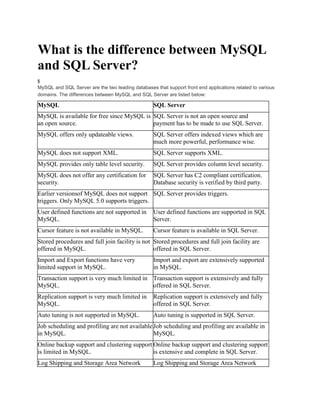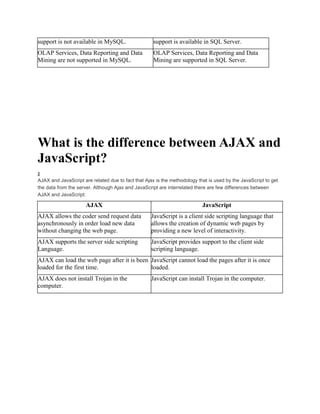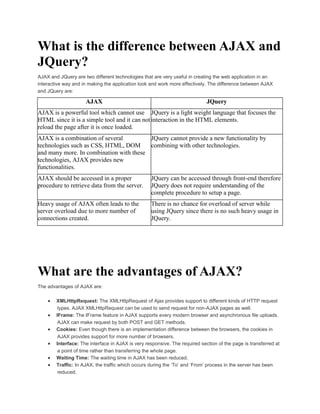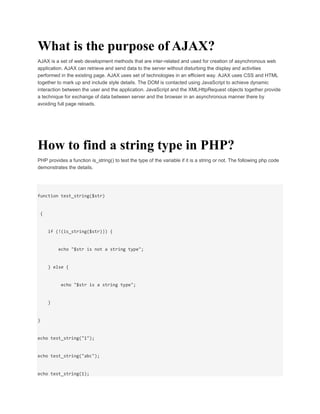Differences
- 1. What is the difference between MySQL and SQL Server? 6 MySQL and SQL Server are the two leading databases that support front end applications related to various domains. The differences between MySQL and SQL Server are listed below: MySQL SQL Server MySQL is available for free since MySQL is an open source. SQL Server is not an open source and payment has to be made to use SQL Server. MySQL offers only updateable views. SQL Server offers indexed views which are much more powerful, performance wise. MySQL does not support XML. SQL Server supports XML. MySQL provides only table level security. SQL Server provides column level security. MySQL does not offer any certification for security. SQL Server has C2 compliant certification. Database security is verified by third party. Earlier versionsof MySQL does not support triggers. Only MySQL 5.0 supports triggers. SQL Server provides triggers. User defined functions are not supported in MySQL. User defined functions are supported in SQL Server. Cursor feature is not available in MySQL. Cursor feature is available in SQL Server. Stored procedures and full join facility is not offered in MySQL. Stored procedures and full join facility are offered in SQL Server. Import and Export functions have very limited support in MySQL. Import and export are extensively supported in MySQL. Transaction support is very much limited in MySQL. Transaction support is extensively and fully offered in SQL Server. Replication support is very much limited in MySQL. Replication support is extensively and fully offered in SQL Server. Auto tuning is not supported in MySQL. Auto tuning is supported in SQL Server. Job scheduling and profiling are not available in MySQL. Job scheduling and profiling are available in MySQL. Online backup support and clustering support is limited in MySQL. Online backup support and clustering support is extensive and complete in SQL Server. Log Shipping and Storage Area Network Log Shipping and Storage Area Network
- 2. support is not available in MySQL. support is available in SQL Server. OLAP Services, Data Reporting and Data Mining are not supported in MySQL. OLAP Services, Data Reporting and Data Mining are supported in SQL Server. What is the difference between AJAX and JavaScript? 2 AJAX and JavaScript are related due to fact that Ajax is the methodology that is used by the JavaScript to get the data from the server. Although Ajax and JavaScript are interrelated there are few differences between AJAX and JavaScript: AJAX JavaScript AJAX allows the coder send request data asynchronously in order load new data without changing the web page. JavaScript is a client side scripting language that allows the creation of dynamic web pages by providing a new level of interactivity. AJAX supports the server side scripting Language. JavaScript provides support to the client side scripting language. AJAX can load the web page after it is been loaded for the first time. JavaScript cannot load the pages after it is once loaded. AJAX does not install Trojan in the computer. JavaScript can install Trojan in the computer.
- 3. What is the difference between AJAX and JQuery? AJAX and JQuery are two different technologies that are very useful in creating the web application in an interactive way and in making the application look and work more effectively. The difference between AJAX and JQuery are: AJAX JQuery AJAX is a powerful tool which cannot use HTML since it is a simple tool and it can not reload the page after it is once loaded. JQuery is a light weight language that focuses the interaction in the HTML elements. AJAX is a combination of several technologies such as CSS, HTML, DOM and many more. In combination with these technologies, AJAX provides new functionalities. JQuery cannot provide a new functionality by combining with other technologies. AJAX should be accessed in a proper procedure to retrieve data from the server. JQuery can be accessed through front-end therefore JQuery does not require understanding of the complete procedure to setup a page. Heavy usage of AJAX often leads to the server overload due to more number of connections created. There is no chance for overload of server while using JQuery since there is no such heavy usage in JQuery. What are the advantages of AJAX? The advantages of AJAX are: XMLHttpRequest: The XMLHttpRequest of Ajax provides support to different kinds of HTTP request types. AJAX XMLHttpRequest can be used to send request for non-AJAX pages as well. IFrame: The IFrame feature in AJAX supports every modern browser and asynchronous file uploads. AJAX can make request by both POST and GET methods. Cookies: Even though there is an implementation difference between the browsers, the cookies in AJAX provides support for more number of browsers. Interface: The interface in AJAX is very responsive. The required section of the page is transferred at a point of time rather than transferring the whole page. Waiting Time: The waiting time in AJAX has been reduced. Traffic: In AJAX, the traffic which occurs during the ‘To’ and ‘From’ process in the server has been reduced.
- 4. What is the purpose of AJAX? AJAX is a set of web development methods that are inter-related and used for creation of asynchronous web application. AJAX can retrieve and send data to the server without disturbing the display and activities performed in the existing page. AJAX uses set of technologies in an efficient way. AJAX uses CSS and HTML together to mark up and include style details. The DOM is contacted using JavaScript to achieve dynamic interaction between the user and the application. JavaScript and the XMLHttpRequest objects together provide a technique for exchange of data between server and the browser in an asynchronous manner there by avoiding full page reloads. How to find a string type in PHP? PHP provides a function is_string() to test the type of the variable if it is a string or not. The following php code demonstrates the details. function test_string($str) { if (!(is_string($str))) { echo "$str is not a string type"; } else { echo "$str is a string type"; } } echo test_string("1"); echo test_string("abc"); echo test_string(1);
- 5. The above code will display the following outputs: 1 is a string type abc is a string type 1 is not a string type





